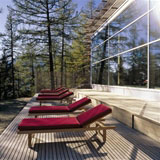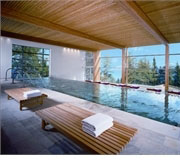Profile: Matteo Thun

Matteo Thun’s multidisciplinary approach has led him from graphics, product and interior design to sustainable architecture. Stephanie Rafanelli asks him about his resort project in the Alps, and why design is dead.
There must be something in the mountain air of the South Tyrol that produces pioneers. The dramatic peaks of the region famously gave birth to mountaineering legend Reinhold Messner. But there is another South Tyrolean who has forged tirelessly onwards and upwards, this time in the world of design – internationally renowned architect, resident of the New York Design Hall of Fame and one-time Memphis revolutionary Matteo Thun. After 35 years, Thun has returned to his home soil to create the third in a series of design hotels that have sparked an Alpine sensation.
The new Steigenberger Hotel and Terme Merano spa complex is a bold new design venture set in the neo-Gothic architecture of 19th century spa town, Merano. Thun inherited the original project from Berlin practice Baumann and Zillich and then set to work creating his own unique interpretation of Alpine design. The hotel’s interior mimics the Tyrolean landscape with apple greens, wine reds, local stone and wood flooring, while gilded deer head lamps with real antlers provide a humorous nod to traditional Alpine decor.
Next to the hotel is Terme Merano, a 2000m2 spa complex encased in a giant glass box. The building offers 25 pools, 26 treatment rooms and eight saunas, all with seamless views of the surrounding snow-capped mountains. A giant installation of multi-coloured Perspex rings, inspired by Saturn, hangs from the glass atrium. For Thun, the barrier between indoors and outdoors has become almost imperceptible.
But the most dynamic aspect of Terme Merano’s design is silent and invisible – an underground tunnel to divert traffic away from the hotel and adjacent River Passer. ‘Acoustics are an important part of design,’ explains Thun. ‘I wanted guests to be free from the noise of traffic and to connect with the sound of the river.’ Terme Merano and Thun’s previous projects in the area mark a move towards ‘site-sensitive design’, capturing ‘the soul of a place.’
It’s hard to believe this is the man who designed the Dunkin’ Donuts logo. But Thun’s canon of work is impossible to categorise, crossing the boundaries of graphics, product and interior design, and architecture. He was creative director of Swatch from 1990 to 1993, designed Chicco cups for Lavazza and got a Compasso D’ Oro for the ‘Girly’ – a female urinal system. On a larger scale, he is responsible for Porsche and Missoni stores, the Coca-Cola Headquarters in Switzerland and Hamburg’s Side Hotel.
Now 54, Thun shrugs off his multidisciplinary approach as a necessity. ‘Italian design happened in the 1950s because of the financial disaster of the architectural system in Italy. We had to design lamps and bath tubs to survive,’ he says. Whether it’s a toilet or an eco-resort, Thun’s imperative today is aesthetic and technical durability. But this was not always the case. In 1981, under the tutelage of the legendary Ettore Sottsass, he became a member of Memphis, the radical design movement that sent shockwaves through the industry by raising a two-fingered salute to the conventional parameters of functionality, shape, form and colour. Instead, humour and kitsch became an expression of disposable consumerism. ‘Memphis was about stopping the grey arrogance of Bauhaus and serial production,’ Thun reiterates. ‘It was a true revolution, but, like Che Guevara’s vision for Cuba, it was ultimately misinterpreted’.

It seems the simplicity and eco-sensitivity of Thun’s Alpine projects are the antithesis of the Memphis ideal: the Pergola Residence is designed to blend into the surrounding vineyard terracettes, and the award-winning Hotel Vigilius is a mountain eco-treehouse only accessible by cable car. But Thun insists that his recent work is not a reaction to, but an evolution of Memphis. ‘Without Memphis, Hotel Vigilius could not have happened,’ he says. ‘This is a completely energy-autonomous hotel. It is a revolution not because of the design, but because of the invisible part, and that’s real sustainability.’
Thun calls this new quiet revolution ‘ecotecture’, a combination of economy, ecology and architecture. For Thun, it is the inevitable replacement of design post 11 September. ‘Design belonged to the 20th century. The falling of the Twin Towers symbolised the collapse of the new economy, the end of consumerism and the death of design.’
For a designer in a designless world, Thun is a very busy man. In the UK alone, he has recently opened the Birmingham Radisson SAS hotel and is working on Missoni’s first boutique hotel in Edinburgh. But his heart is still at home: ‘I would love to build an eco-church in Bolzano’s mountains, which welcomes all religions.’ With the visionary and revolutionary spirit of Thun, anything could happen.
-
Post a comment




